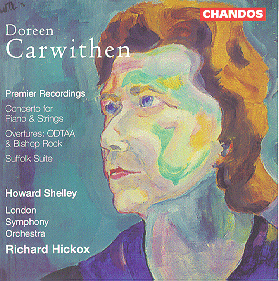THE WILLIAM ALWYN SOCIETY
President: Mary AlwynPatron: Vilem Tausky CBE


Cover Painting: Portrait of my Wife by William Alwyn
Doreen Carwithen (b. 1922) |
| Overture: ODTAA |
| (One Damn Thing After Another) |
| Allegro ma non troppo |
| Concerto for Piano and Strings |
| I Allegro assai |
| II Lento |
| III Moderato e deciso ma con moto |
| Overture: Bishop Rock |
| Allegro con energico |
| Suffolk Suite |
| I Prelude: Moderato |
| II Orford Ness: Allegretto grazioso |
| III Suffolk Morris: Ritmico |
| IV Framlingham Castle: Alla marcia |
| Howard Shelley piano |
| London Symphony Orchestra |
| Igor Gruppmann leader |
| Richard Hickox conductor |
See also a personal review of this recording from Scott Morrison
ODTAA - One Damn Thing After Another
(1945)
The title ODTAA was suggested by the novel
of that name by John Masefield. The music is
in no sense programmatic, but I have
attempted to express in music the colour,
excitement and romantic spirit of adventure
that is the essence of the book.
The Overture begins (Allegro ma non troppo) with a vigorous statement of the main theme on the strings. From this theme most of the material used throughout is derived and developed. A climax is reached with a fanfare- like statement of this subject, followed by a short, accented passage for brass and percussion. The music then quietens to a tranquil middle section which builds to a broad climax. The initial tempo returns, and after a rhythmic recapitulation, the Overture ends, with the fanfare theme played by the full orchestra.
Bishop Rock (1952)
The Bishop Rock lighthouse stands at the
furthermost point of England. Its lonely tower
is the last sight the seafarer has of land, and,
to the traveller from the New World, is a
symbol of welcome after the bleak waters of
the Atlantic. The Overture is an impression of
the thoughts stimulated by the lighthouse and
depicts Bishop Rock in storm and calm.
It begins with a strong repeated motive on the horns, which suggests the intermittent flashing of the light over a stormy sea. After a brief exposition, this is followed by a long phrase on the violins accompanied by horns which rises and sinks like the surge of the Atlantic swell. The music grows to a climax and gradually subsides to a gentle transformation of the theme (which was first heard fortissimo on the strings at the climax) on the bass clarinet, then on the bassoons, the horns and finally a solo violin. It suggests the sea gently lapping against the rocks. A rhythmic figure on the cellos and basses disturbs the calm and the music develops to a strong recapitulation of the 'lighthouse' theme.
The Concerto for Piano and Strings was
completed in 1948 and contains much
vigorous, brilliant writing for the soloist set
against a sensitive use of the strings. The first
movement Allegro assai has two subjects, The
first, announced immediately by the piano in
octaves, grows into a whole section in which it
receives a variety of treatment. After a
morendo the soloist then introduces the
second subject, which is immediately followed
by a quasi-cadenza. The two themes,
developed and recapitulated, bring the
movement to a close.
The slow movement, Lento, begins with the
solo violin announcing a melody which is
echoed by the piano. Their duet continues
throughout the movement, accompanied by
muted strings.
The Finale, Moderato e deciso ma con moto,
is introduced by a broad, chordal melody
played by the strings against a rising scale
passage on the piano. These two ideas form
the main material for the whole movement. It
ends with an extended cadenza followed by a
coda which states again the broad melody of
the main theme.
© 1997 Doreen Carwithen
 Return to Alwyn home page
Return to Alwyn home page